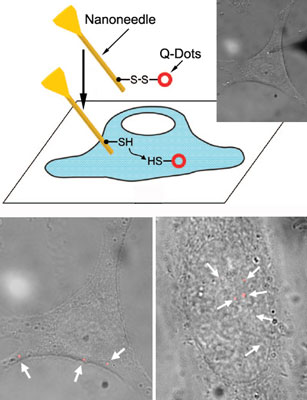Pin-Point Precision: Nano-Cell Biology
 These new gold-plated boron nitride nanotube - nanoneedles from the University of Illinois are a good example of technology convergence. The ability to discover the intimate workings between cell and molecular biology have never been as strong, thanks to the use of these special nano-biotechnological devices. Here is how it works:
These new gold-plated boron nitride nanotube - nanoneedles from the University of Illinois are a good example of technology convergence. The ability to discover the intimate workings between cell and molecular biology have never been as strong, thanks to the use of these special nano-biotechnological devices. Here is how it works:To create a nanoneedle, the researchers begin with a rigid but resilient boron-nitride nanotube. The nanotube is then attached to one end of a glass pipette for easy handling, and coated with a thin layer of gold. Molecular cargo is then attached to the gold surface via “linker” molecules. When placed in a cell’s cytoplasm or nucleus, the bonds with the linker molecules break, freeing the cargo.Extremely cool tool. The possibilities are beyond current comprehension. These techniques will no doubt be used in induced stem cell studies, and in all kinds of differentiation - dedifferentiation studies. And that is only the beginning.
With a diameter of approximately 50 nanometers, the nanoneedle introduces minimal intrusiveness in penetrating cell membranes and accessing the interiors of live cells.
The delivery process can be precisely controlled, monitored and recorded – goals that have not been achieved in prior studies. “The nanoneedle provides a mechanism by which we can quantitatively examine biological processes occurring within a cell’s nucleus or cytoplasm,” said Yang Xiang, a professor of molecular and integrative physiology and a co-author of the paper. “By studying how individual proteins and molecules of DNA or RNA mobilize, we can better understand how the system functions as a whole.” _Nanowerk
The dream is consilience -- the unified study of knowledge in real time. This type of tool allows for one small part of the dream.
Labels: biological world, cell biology

0 Comments:
Post a Comment
“During times of universal deceit, telling the truth becomes a revolutionary act” _George Orwell
<< Home